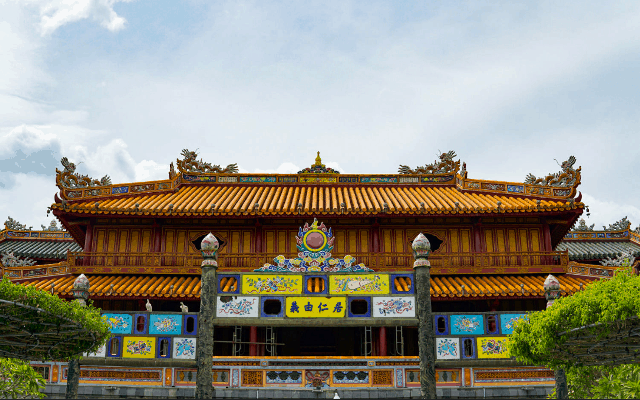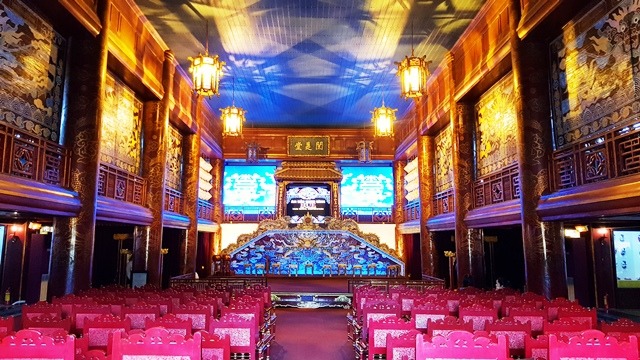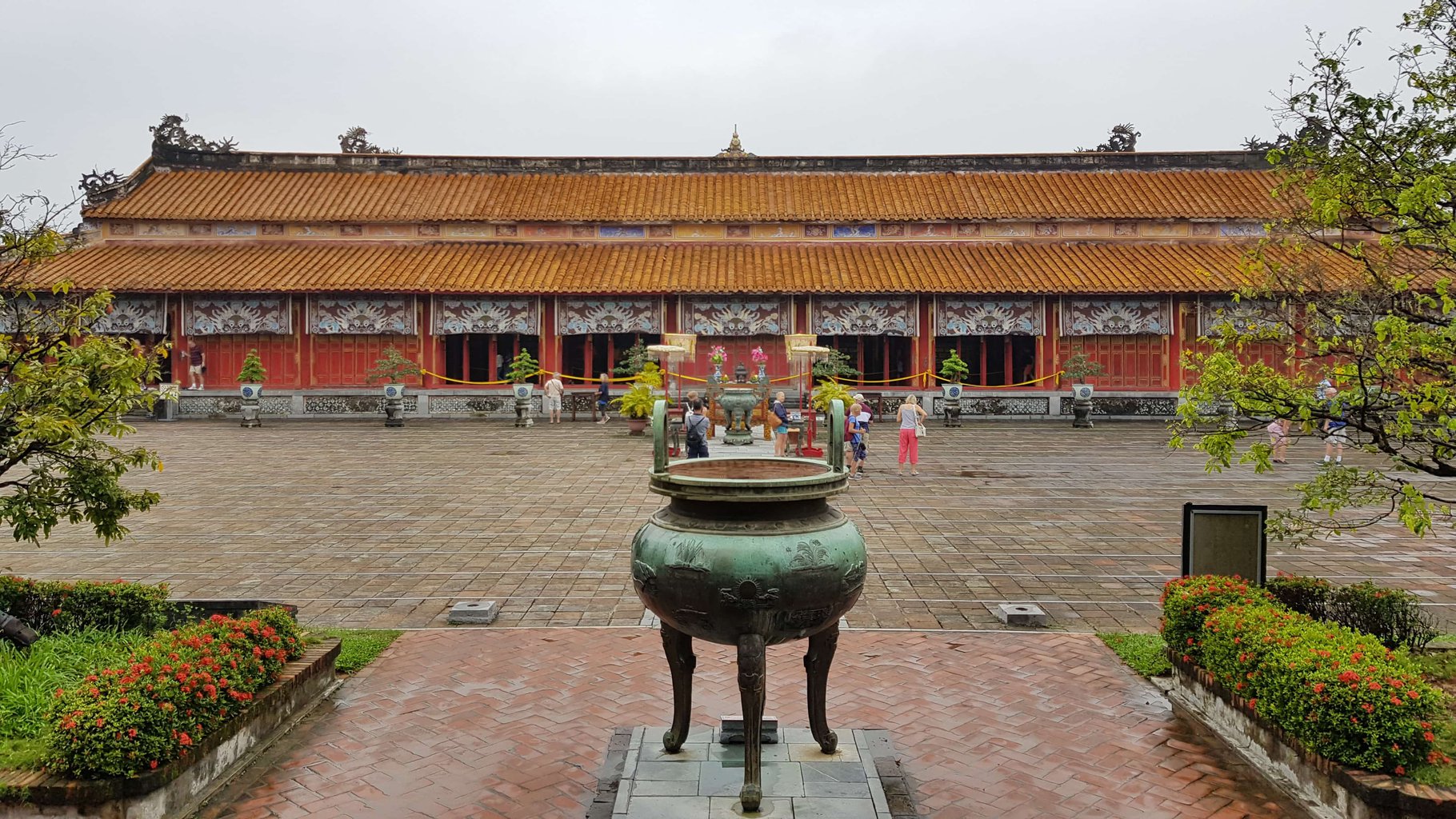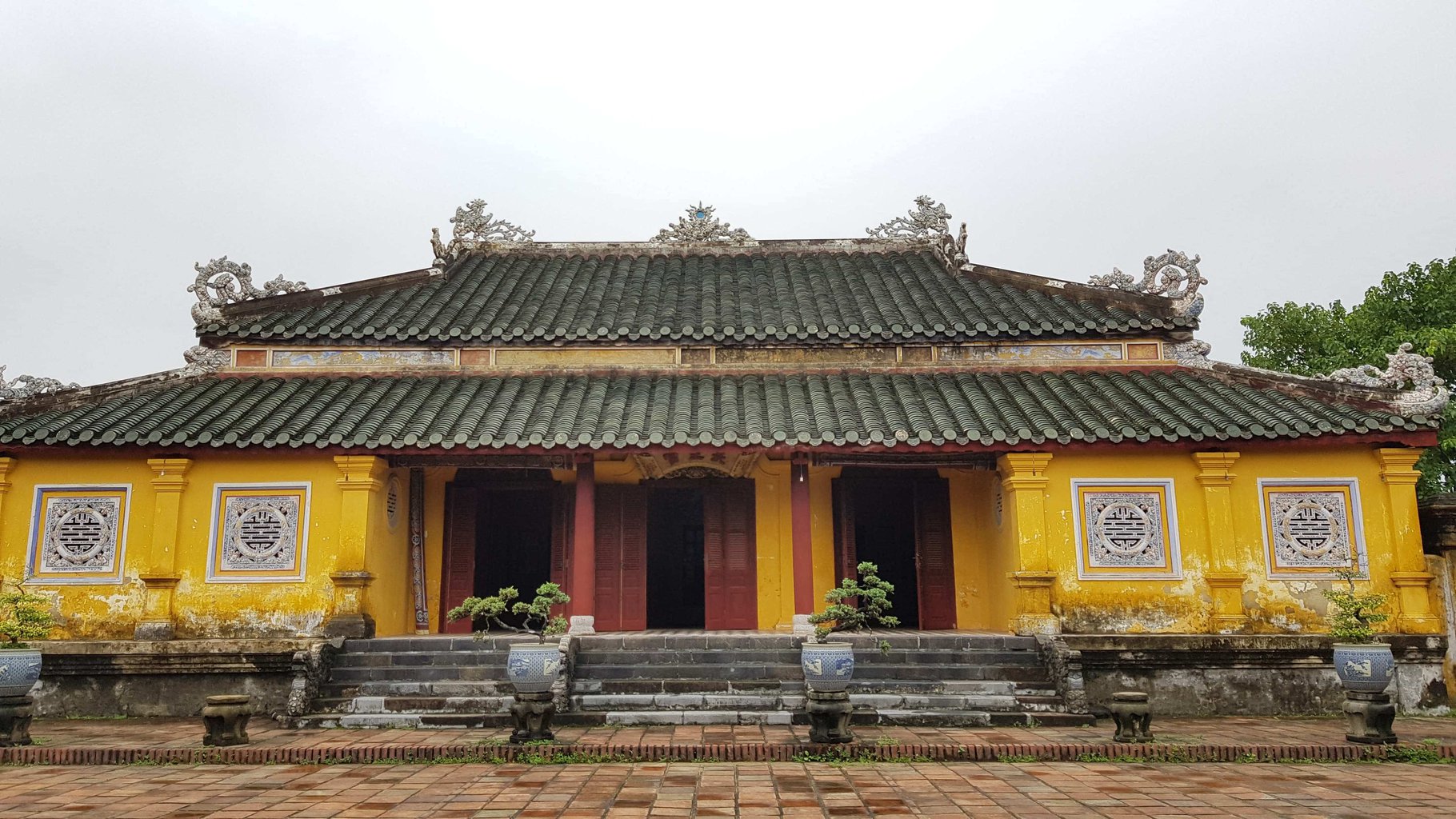HUE IMPERIAL CITY OF THE NGUYEN DYNASTY
HUE IMPERIAL CITY OF THE NGUYEN DYNASTY
Located in the center of Vietnam, Hue served as the capital of the Nguyen Dynasty from 1802 to 1945. This wonderful place comprises many cultural monuments including palaces, temples, and tombs. Especially, Hue Imperial City (Hue Citadel), which is the UNESCO Heritage Site, has been one of the most outstanding structures that feudal palace lovers should not miss.
Table Of Contents [hide]
1. Hue Citadel’s history
This Hue citadel complex is the place that the 9 Nguyen Lords and 13 Nguyen Dynasty Emperors chose to live and govern the country. To be accurate, in 1803, Emperor Gia Long himself examined the terrain to choose a suitable place to build this massive complex. In fact, it took 31 years to complete from 1802 to 1833.

Located on the North bank of Perfume River, in the center of the city which is 10.000 m in circumference. Fascinatingly, based on the geographic and Fengshui principles, emperors constructed the Hue Citadel facing the South and picking Ngu Binh mountain as the front screen. Besides, the King planned the architectural system in accordance with the well-proportioned principle. Surrounding the citadel of Hue, there is a total of 10 gates and a 7 km long moat for decoration, protection and to be a natural air-conditioner.
2. Imperial City Hue map
3. Hue citadel’s structure
Hue Citadel consists of an area of 500 ha and includes three ramparts.
The first area is the Kinh Thanh Hue (Hue Citadel). In reality, Emperor Gia Long ordered builders to construct it in the year 1805. Regardless of the time and natural disasters, this building was stable with 140 huge constructions. Specifically, it is 9 kilometers in circumference with 10 gates. Additionally, 24 bastions were set up on the top of the walls with defensive aims.
The second area behind Noon Gate is the Royal City. As you know, it is considered the most crucial part of the citadel since this is the place to hold some grand ceremonies, put the shrines. the working area of the Emperor and mandarins. Moreover, the meetings about internal affairs happened here as well.
The last section is the Hue Forbidden City. It was built in 1803 to be the private residence of emperors, the royal family, and eunuchs. At first, Gia Long named it Cung Thanh and then he changed into Tu Cam Thanh in 1821. Around it, there are bricks walls of 3 meters high and 0.7 meters thick.
4. Hue Imperial City palace views 360 looked from outside
5. What to see at Hue Imperial City?
5.1. Noon Gate

It is the iconic symbol of the formal Royal City. It was the main gate to enter into the Royal city. The Noon Gate was the last monument built-in 1833 with 5 entrances. Specifically, the central gate and yellow door were only for the emperor. On the right for civil mandarins and on the left for military mandarins. On two-wings, there are 2 more gates for soldiers, horses, and elephants. Interestingly, it is a U-shaped building that made by huge wooden doors, stone foundation, and brick.
5.2 Ngu Phung palace
On the Noon Gate is the Ngu Phung palace. This special building consists of 100 columns, Its roofs tiled in the yin-yang style. Remarkably, the yellow royal tiles area only for the Emperor and the green royal tiles roofed for the mandarins and royalties. The decoration topic is about dragons, the symbol for the power of the Emperor. To be specific, the palace had been used as a stage for major royal ceremonies.

This special construction, which is the most powerful symbol of the Nguyen Dynasty, is the historic witness of a lot of battles especially Tet Mau Than Offensive in 1968. Nowadays, thanks to the gifted craftwork and enthusiastic support, it appears stunning with a new appearance.
5.3 Thai Hoa Palace (Supreme Harmony Palace)

In this most important palace, only twice a month, following the Lunar calendar, Emperor worked inside with 4 highest-ranking mandarins, other mandarins were on the royal courtyard, entering inside to do business with the emperor. The palace only used for some special ceremonies such as the coronation of 13 Emperors, the Emperor’s birthday and the significant meetings with envoys from other countries.
Even though it was under renovations, large-scaled re-construction, it remains its main historic beauty. Distinctively, the palace’s roof is famous for its unique style. It comprises the upper roof, the lower one, and the eaves.
In a closer look, in the roof, there are many dragons, suns and moon images. Honestly, they symbolize for the emperor and the Oriental philosophy.
5.4 Duyet Thi Duong Royal Theater

Under the reign of Gia Long Emperor, they constructed this building for Emperors and royal family members to entertain and enjoy the conventional art performances, especially royal dance, dramas, royal court-music.
Furthermore, it is the place for royal banquets and nowadays, in special festivals, this theater is the venue to display Hue Royal Court-music, which is a Unesco world Masterpiece of Oral and Intangible heritage.
5.5 The To Temple (The Royal Family Temple)

It was constructed in 1821 by Minh Mang Emperor in order to worship Emperor Gia Long, the founder of the Nguyen dynasty. Lately, they worship almost Emperors of the Nguyen Dynasty. 3 deposed Emperors such as Duc Duc, Hiep Hoa, and Bao Dai are not allowed to be worshiped in. In the past, women could not enter.
5.6 Cung Dien Tho

It was the private residence area of the Emperor’s mother and grandmother. it is the most massive building which is kept intact nowadays. Accurately, this construction consists of over 10 buildings that were covered with a rectangular-shaped wall. The buildings in this place were connected with a roofed corridor system. Every day, the Emperor walked in this corridor to visit his mom.
6.Things to know before visiting Hue Citadel
6.1. Hue Citadel – Vietnam Entrance fee
At present, an entrance ticket for adults costs VND 150.000 and VND 40.000 for kinds. In 2020 it will costs VND 200.000 ( approximately USD 8.7 ) and VND 40.000 (roughly 1.7 USD ) for kids from 7 to 12 years old.
Hue imperial city guide:
- Hue city group tour – deluxe group tour
- Hue city tour – private tour full day
- Hue city tour by cyclo – half day tour
- Hue street food tour
- Hue to hoi an stop at the city of ghosts
Some reference information about the Hue entrance fee just the advice from Culture Pham Travel. The Hue entrance fee can be changed depends on the season, time, children, group policy… If you join the tour of Culture Pham Travel. Fees will be charged to the tour fee.
6.2. Hue Citadel opening hours
Honestly, the Imperial City is so massive that tourists can spend half a day discovering it. Therefore, travelers should not pay a visit to this place from 7 a.m to 5 p.m. It opens every day even in the New Year.
In April and June, there are many colorful festivals such as Kite or Ao Dai festival, and both of them attract a huge number of foreign and domestic visitors. Therefore, if you come here on these special occasions, you might experience many interesting cultural activities.
7. Amazing activities in Hue imperial city.
If tourists wish to be the Emperor, prince, or a princess in the modern time, their desire can be true when they come to Hue Citadel. In this ancient place, they have the chance to put on Imperial clothes to take photos.
Additionally, the journey is pretty long and tourists may feel tired in boiling days, you can take the electric golf-cars with 8 seats to help reduce their exhaust at affordable prices.
Moreover, there are some royal music performances in the royal city that you can enjoy for free.
with a group from 8 people, you will get a free souvenir photo from the local photographers in the citadel.
These days, you can get the audio guide service with multi-languages so you can easily enjoy and spend your time in Hue Imperial city as much as you like.
Moreover, there are some royal music performances in the royal city that you can enjoy for free.
with a group from 8 people, you will get a free souvenir photo from the local photographers in the citadel.
These days, you can get the audio guide service with multi-languages so you can easily enjoy and spend your time in Hue Imperial city as much as you like.
8. How to get to Hue Citadel?
There are many ways to get to Hue Citadel such as walking, booking grab bikes or catching a cyclo. Another way to enjoy the sense of authentic experience and deeply understand with a knowledgeable local tour guide, let’s join in Hue City Tours full day with Culture Pham Travel.
It is advisable to bring sunglasses, suncream, boiled water with you. Besides, don’t forget to take your umbrella or raincoat in case it rains.
Let’s join to explore Hue imperial citadel with us!

Comments
Post a Comment